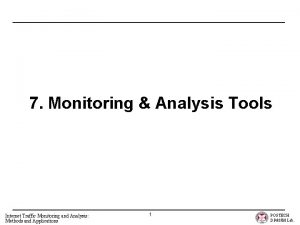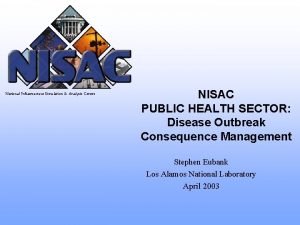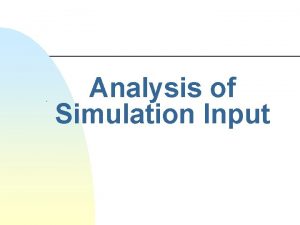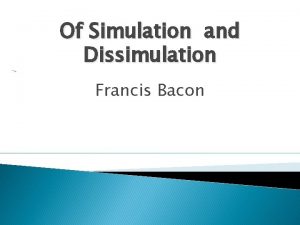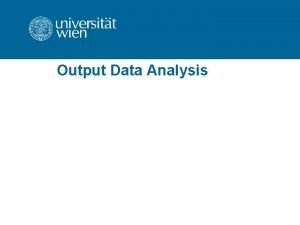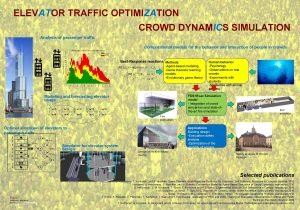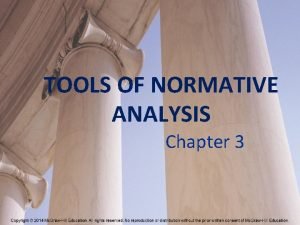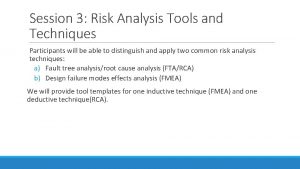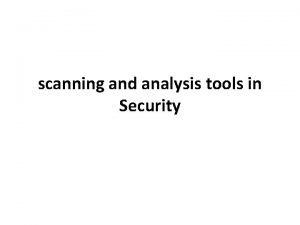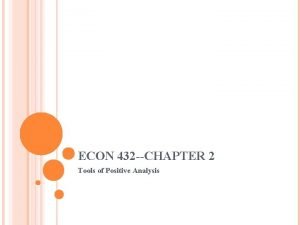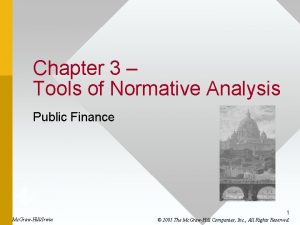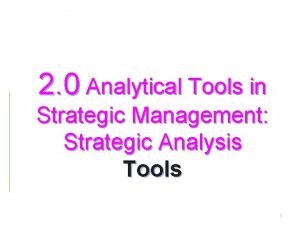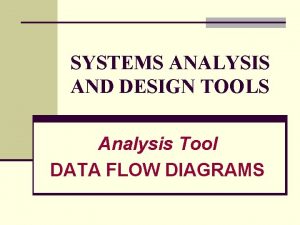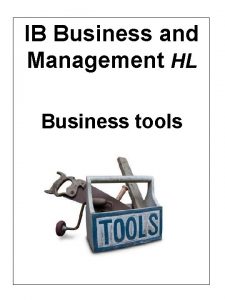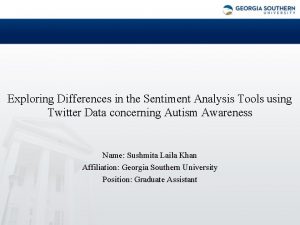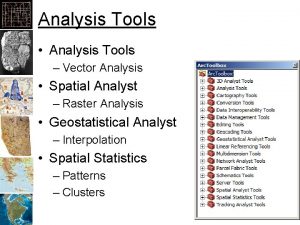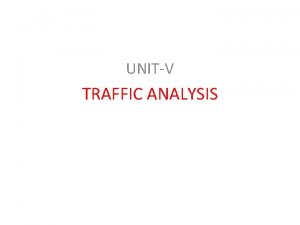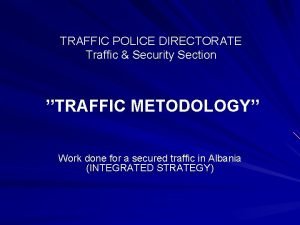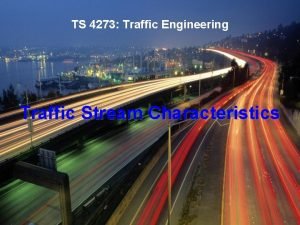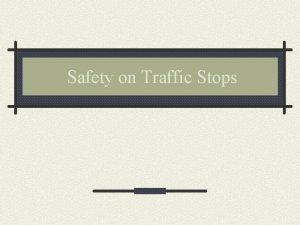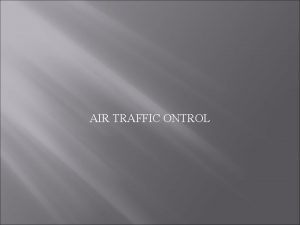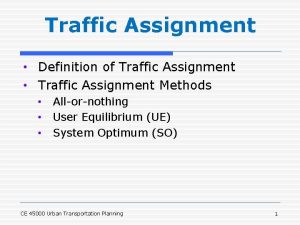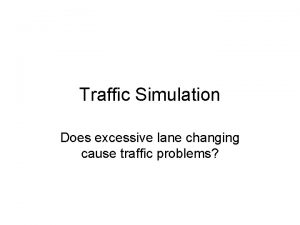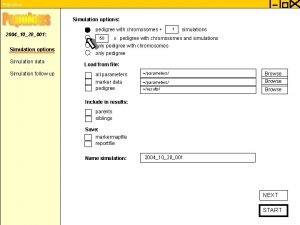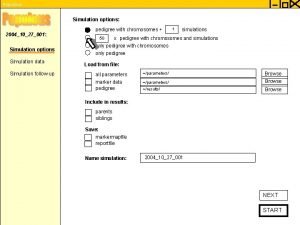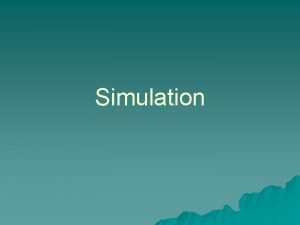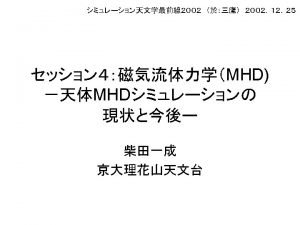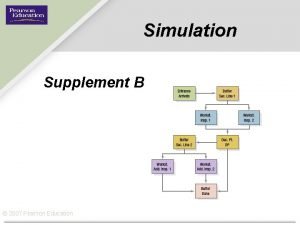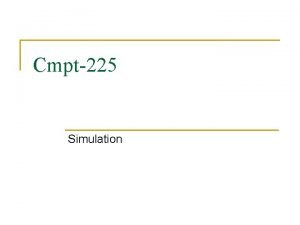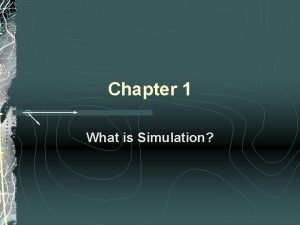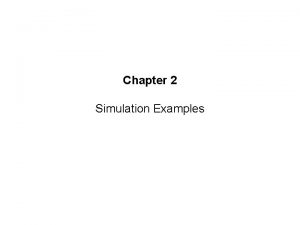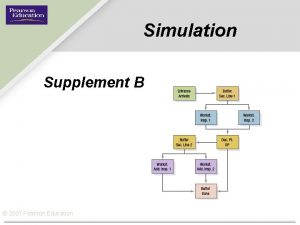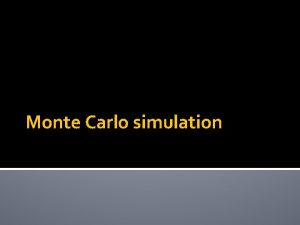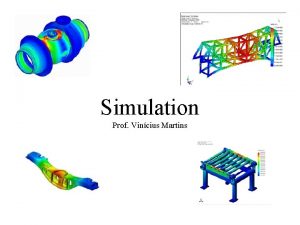Traffic Simulation L 3 Traffic Analysis tools Ing


























- Slides: 26

Traffic Simulation L 3 – Traffic Analysis tools Ing. Ondřej Přibyl, Ph. D.

Discussion What is a traffic analysis tool? What are its objectives? Course: Traffic Simulation L 3: Traffic Analysis Tools 2

Traffic analysis tools Describe a variety of software-based analytical procedures and methodologies that support different aspects of traffic and transportation analyses. Include methodologies such as l sketch-planning, – a picture drawn in plan view that distills certain key components of a landscape to tell a story about a place that words could not express as succinctly travel demand modeling, l traffic signal optimization, l traffic simulation. l Course: Traffic Simulation L 3: Traffic Analysis Tools 3

Role of Traffic Analysis Tools 1. 2. 3. 4. 5. 6. 7. Improve the decision making process Evaluate and prioritize planning/operational alternatives Improve design and evaluation time and costs Reduce disruptions to traffic Present/market strategies to the public/stakeholders Operate and manage existing roadway capacity Monitor performance Course: Traffic Simulation L 3: Traffic Analysis Tools 4

1. Improve the decision making process Traffic analysis tools help practitioners arrive at better planning/engineering decisions for complex transportation problems. l Used to estimate the impact of the deployment of traffic management and other strategies, l Used to help set priorities among competing projects. l In addition, they can provide a consistent approach for comparing potential improvements or alternatives. l Course: Traffic Simulation L 3: Traffic Analysis Tools 5

2. Evaluate and prioritize planning/operational alternatives This typically involves comparing “no build” conditions with alternatives, which include various types of potential improvements. l The impacts are reported as performance measures and are defined as the difference between the no-build and alternative scenarios. l The results can be used to select the best alternative or prioritize improvements, increasing the odds of having a successful deployment. l Course: Traffic Simulation L 3: Traffic Analysis Tools 6

3. Improve design and evaluation time and costs Traffic analysis tools are relatively less costly when compared to pilot studies, field experiments, or full implementation costs. l Furthermore, analytical tools can be used to assess multiple deployment combinations or other complex scenarios in a relatively short time. l Course: Traffic Simulation L 3: Traffic Analysis Tools 7

4. Reduce disruptions to traffic Traffic management and control strategies come in many forms and options, and analytical tools provide a way to cheaply estimate the effects prior to full deployment of the management strategy. l They may be used to initially test new transportation management systems concepts without the inconvenience of a field experiment. l Course: Traffic Simulation L 3: Traffic Analysis Tools 8

5. Present/market strategies to the public/stakeholders l Some traffic analysis tools have excellent graphical and animation displays, which could be used as tools to show “what if” scenarios to the public and/or stakeholders. Course: Traffic Simulation L 3: Traffic Analysis Tools 9

6. Operate and manage existing roadway capacity l Some tools provide optimization capabilities, recommending the best design or control strategies to maximize the performance of a transportation facility. Course: Traffic Simulation L 3: Traffic Analysis Tools 10

7. Monitor performance Analytical tools can also be used to evaluate and monitor the performance of existing transportation facilities. l In the future, it is hoped that monitoring systems can be directly linked to analytical tools for a more direct and realtime analysis process. l Course: Traffic Simulation L 3: Traffic Analysis Tools 11

Categories of Traffic Analysis Tools Sketch-planning tools Travel demand models Analytical/deterministic tools (HCM-based) Traffic signal optimization tools Macroscopic simulation models Mesoscopic simulation models Microscopic simulation models Course: Traffic Simulation L 3: Traffic Analysis Tools 12

Area Geographical area coverage UTPS Highway Capacity Manual Macroscopic models Facility Microsimulation Streets Course: Traffic Simulation Intersections Groups of vehicles L 3: Traffic Analysis Tools Individual vehicles 13

Travel demand models (UTPS) Travel demand models were originally developed to determine the benefits and impact of major highway improvements in metropolitan areas. l However, they were not designed to evaluate travel management strategies, such as intelligent transportation systems (ITS)/operational strategies. l They have only limited capabilities to accurately estimate changes in operational characteristics (such as speed, delay, and queuing) resulting from implementation of ITS/operational strategies. l Four step model: – See Next slide l Course: Traffic Simulation L 3: Traffic Analysis Tools 15

Four step model Course: Traffic Simulation L 3: Traffic Analysis Tools 16

Analytical/deterministic tools (HCM-based) Most analytical/deterministic tools implement the procedures of the Highway Capacity Manual (HCM). l These tools quickly predict capacity, density, speed, delay, and queuing on a variety of transportation facilities and are validated with field data, laboratory test beds, or small-scale experiments. l Analytical/deterministic tools are good for analyzing the performance of isolated or small-scale transportation facilities l However, they are limited in their ability to analyze network or system effects. l Course: Traffic Simulation L 3: Traffic Analysis Tools 17

Macroscopic simulation models Based on the deterministic relationships of the flow, speed, and density of the traffic stream. l The simulation in a macroscopic model takes place on a section-by-section basis rather than by tracking individual vehicles. l They have considerably fewer demanding computer requirements than microscopic models. l They do not, however, have the ability to analyze transportation improvements in as much detail as the microscopic models. l Course: Traffic Simulation L 3: Traffic Analysis Tools 19

Mesoscopic simulation models l l l Mesoscopic simulation models combine the properties of both microscopic (discussed below) and macroscopic simulation models. As in microscopic models, the mesoscopic models’ unit of traffic flow is the individual vehicle. Their movement, however, follows the approach of the macroscopic models and is governed by the average speed on the travel link. Mesoscopic model travel simulation takes place on an aggregate level and does not consider dynamic speed/volume relationships. As such, they provide less fidelity than the microsimulation tools, but are superior to the typical planning analysis techniques. Course: Traffic Simulation L 3: Traffic Analysis Tools 20

Microscopic simulation models They simulate the movement of individual vehicles based on car-following and lane-changing theories. l Typically, vehicles enter a transportation network using a statistical distribution of arrivals (a stochastic process) and are tracked through the network over small time intervals (e. g. , 1 second or a fraction of a second). l Typically, upon entry, each vehicle is assigned a destination, a vehicle type, and a driver type. l Computer time and storage requirements for microscopic models are large, usually limiting the network size and the number of simulation runs that can be completed. l Course: Traffic Simulation L 3: Traffic Analysis Tools 21

Challenges and Limitations in the Use of Traffic Analysis Tools (1) l l l l Availability of quality data Limited empirical data (know-how) Limited funding Training limitations Limited resources Data input and the diversity and inconsistency of data Lack of understanding of the limitations of analytical tools Course: Traffic Simulation L 3: Traffic Analysis Tools 22

Challenges and Limitations in the Use of Traffic Analysis Tools (2) l l l Tool may not be designed to evaluate all types of impacts produced by transportation strategies/applications. Lack of features Desire to run real-time solutions Tendency to use simpler analytical tools and those available in house, although they might not be the best tools for the job Biases against models and traffic analysis tools Long computer run times Course: Traffic Simulation L 3: Traffic Analysis Tools 23

Simulation Strengths and Limitations l l l l Effective in evaluating the dynamic evolution of traffic congestion Can evaluate the interference that occurs when congestion builds up at one location and impacts the capacity of another location Can model the variability in driver/vehicle characteristics Require a lot of of input data, considerable error checking of the data, and manipulation of a large amount of potential calibration parameters Cannot be applied to a specific facility without the calibration of those parameters to the actual conditions in the field Calibration can be a complex and time consuming process The algorithms are mostly developed independently and are not subject to peer review and acceptance in the professional community Course: Traffic Simulation L 3: Traffic Analysis Tools 25

Traffic Performance Measures: Differences Between HCM and Simulation HCM methodologies and tool procedures Simulation models Static approach Dynamic approach Estimates the average density, speed, or delay over the peak 15 minutes of an hour Predict density, speed, and delay for each time slice within the analysis period Reports density in terms of equivalent passenger cars Report density for actual vehicles Reports all delay caused by a given bottleneck Report delay only on the street segment where vehicles are slowed down Reports all queued vehicles caused by a given bottleneck Report queues only on the street segment where vehicles are actually queued Do not necessarily report control delay at signalized intersections. Course: Traffic Simulation L 3: Traffic Analysis Tools 26

Criteria for Selecting the Appropriate Type of Traffic Analysis Tool (1) The first step is identification of the analytical context for the task planning, l design, or l operations/construction. l Course: Traffic Simulation L 3: Traffic Analysis Tools 27

Criteria for Selecting the Appropriate Type of Traffic Analysis Tool (2) l l l l Ability to analyze the appropriate geographic scope or study area for the analysis, including an isolated intersection, single roadway, corridor, or network. Capability of modeling various facility types, such as freeways, highoccupancy vehicle (HOV) lanes, ramps, arterials, toll plazas, etc. Ability to analyze various travel modes, such as single-occupancy vehicle (SOV), HOV, bus, train, truck, bicycle, and pedestrian traffic. Ability to analyze various traffic management strategies and applications, such as ramp metering, signal coordination, incident management, etc. Capability of estimating traveler responses to traffic management strategies, including route diversion, departure time choice, mode shift, destination choice, and induced/foregone demand. Ability to directly produce and output performance measures, such as safety measures (crashes, fatalities), efficiency (throughput, volumes, vehicle-miles of travel (VMT)), mobility (travel time, speed, vehicle-hours of travel (VHT)), productivity (cost savings), and environmental measures (emissions, fuel consumption, noise). Tool/Cost-Effectiveness for the task, mainly from a management or operational perspective. Course: Traffic Simulation L 3: Traffic Analysis Tools 28

Thank you for your attention Questions?
 Internet traffic analysis tools
Internet traffic analysis tools Inbound traffic vs outbound traffic
Inbound traffic vs outbound traffic All traffic solutions traffic cloud
All traffic solutions traffic cloud What are structured analysis tools?
What are structured analysis tools? Simulation modeling and analysis law kelton
Simulation modeling and analysis law kelton National infrastructure simulation and analysis center
National infrastructure simulation and analysis center Input analysis simulation
Input analysis simulation Difference between simulation and dissimulation
Difference between simulation and dissimulation Of simulation and dissimulation
Of simulation and dissimulation Output data analysis in simulation
Output data analysis in simulation The appropriate cutting tool used in cutting fabrics
The appropriate cutting tool used in cutting fabrics Traffic flow analysis in retail management
Traffic flow analysis in retail management Elevator traffic analysis
Elevator traffic analysis Tools of positive analysis in public finance
Tools of positive analysis in public finance Tools of normative analysis
Tools of normative analysis Risk analysis tools and techniques
Risk analysis tools and techniques Scanning and analysis tools
Scanning and analysis tools Case tools are limited to systems analysis.
Case tools are limited to systems analysis. Swot hbr
Swot hbr Tools of positive analysis
Tools of positive analysis Tools of normative analysis
Tools of normative analysis Tools of normative analysis
Tools of normative analysis Analytical tools in strategic management
Analytical tools in strategic management Firewall analysis tool
Firewall analysis tool System analysis and design tools
System analysis and design tools Business management tools ib
Business management tools ib Sentiment analysis tools comparison
Sentiment analysis tools comparison
